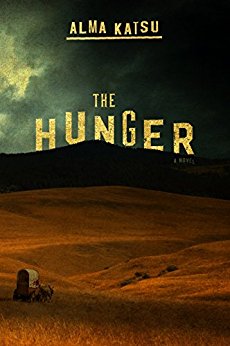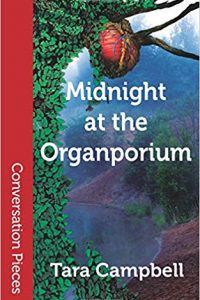Stefan Dziemianowicz reviews The Hunger by Alma Katsu
 The Hunger, Alma Katsu (Putnam 978-0-06-7352-1251-0, $27.00, 38pp, hc) March 2018.
The Hunger, Alma Katsu (Putnam 978-0-06-7352-1251-0, $27.00, 38pp, hc) March 2018.
The tragic fate of the Donner Party is one of the true American horror stories of the 19th century. The collective of 87 family members and individuals set out from Missouri in May 1846 as part of a larger California-bound wagon train caravan. They epitomized the American pioneer spirit and the nation’s snowballing sense of manifest destiny. Soon thereafter, they came to epitomize the underestimation many settlers made of the rigors of pioneer life and the terra incognita of the American west. Misled by a charlatan guide into taking a little-known ‘‘faster’’ route, they wound up snowbound in the Sierra Nevada mountains in October. Only 48 survivors made it to California by April of the following year, and folklore about them ever since has been fueled by speculation – disputed by some and disregarded by others – that the living survived the winter only by eating the corpses of their fellow pioneers.
For her novel The Hunger, Alma Katsu has fleshed out the bare bones (if you will) of what is known about the ordeal of the Donner party, providing its players with backstories and motivations and injecting the drama in which they interact with more than a hint of supernatural interventions. The result is a colorful historical horror novel that evokes a time in America when its underexplored wilderness teemed with terrors impressed upon it by the darkest imaginings of its superstitious settlers and the folk legends that nurtured them.
Katsu’s narrative is panoramic, presented from the viewpoints of many persons in the historical record who serve as her characters, but two clear protagonists emerge early in the telling of her tale. The first is Edwin Bryant, a journalist fascinated with the Native American cultures that are being pushed to extinction by the westward migration of settlers like the Donner Party. Familiar with the Paiute and other native tribes who still populate the territories that the Donners are traveling through, and passably fluent in their languages, Bryant serves as a Charles Marlow-type character who is unaware (at least initially) that his explorations are a plunge into the heart of darkness of the American wilds, where the boundary between the real and the imagined, the ordinary and the mythic wears dangerously thin. His investigation of the Anawai, a tribe whom the other tribes are reticent to talk about, and the Anawai’s unorthodox worship of a wolf spirit, or demon, is a cloud that casts a darkening shadow over events as the Donner Party penetrates deeper into a terrain that reveals itself to be savage and unrelenting. Katsu’s other main character is Charles Stanton, a solitary traveler riding with the wagon train whose independence gives him an outsider’s perspective on the family and group dynamics that complicate the trek. Stanton is also leaving behind a troubled past in Massachusetts, a personal experience that sheds a light on the failures, private embarrassments, and general restlessness that are motivating most of the other pioneers to seek their fortune in the west.
The novel begins in earnest with a child missing mysteriously from the wagon train in the Nebraska territory. The discovery of his remains, savaged in a way that defies attribution to the habits of natural predators, rouses the apprehensions of the pioneers who are striving to accept the sensibleness of their decision to forsake the familiar world that they know and cast their lots for a migration fraught with the uncertain and the unpredictable. In the chapters that immediately follow, Katsu develops the lives of her characters, giving them backgrounds that, whether or not historically factual, help to establish the foundations for their roles in the drama to come and the fault lines that will fracture the social contract they share when the going gets tough, resources dwindle, and the worst of human nature begins to express itself. Those fault lines become more unstable with each new portent Katsu introduces into the narrative: a way station filled with personal notes from pioneers who have preceded the Donners urging anyone who reads them to turn back for the safety of their lives; tales of prospectors who disappeared into the wilderness and never returned – or who reappeared insane; the discovery of the remains of natives who may have been left as blood sacrifices to… something.
Katsu modulates her horrors skillfully. More butcheries occur. Shadowy figures are seen on the periphery of the camp. The party’s suspicion that they are being stalked by predators only aggravates the tensions that are starting to pull the settlers apart as rations evaporate and the harsh reality of their inescapable predicament sets in. Teenage Elitha Donner, who hears voices in her head, wonders if the party’s presumed stalkers are a projection of its growing emotional discords, ‘‘as though their worst inner fears had taken shape and grown limbs, as though the demons that had often visited Elitha’s mind in the form of voices had sprouted into half-living monsters come to haunt them all.’’
Early in its telling, Katsu weaves the prospect of the fantastic into the fabric of her novel through the revelation that Tamsen Donner, the young wife of the party’s patriarch, is an adept at herbal medicine and considered by some to be a witch. That prospect gains more traction when Bryant, split off from the party, powwows with a Washoe tribe, who speculate that the group of prospectors who disappeared into the wilderness some time back, became infected with ‘‘the na’it’’: ‘‘It is the hunger. A bad spirit that can pass from man to man.’’ Indeed, several members of the party in extremis go mad and exhibit near-feral behavior that supports the idea of a voracious spirit taking possession of them. But Katsu doesn’t take the easy path of blaming the horror overtaking the party on a cliché spirit entity. Struggling to reconcile the supernatural speculations of the Washoe with his own naturalist inclinations, Bryant begins thinking of the hunger in terms of a disease: ‘‘A disease and its symptoms were not necessarily the same things. The disease is something alive but invisible – almost like a spirit, in fact – that then takes hold in the body and causes symptoms, sometimes different symptoms in different people. Sometimes, even, causing no symptoms a t a ll.’’ This is a deft turn by Katsu, because it casts the explanation for the menace threatening the party, which has been verging on the supernatural, back into the realm of the rational and explicable. What is the disease that is afflicting the pioneers, causing some to show symptoms and others not? Where did the infection take hold? Was it present in one of the way station cabins that the party stopped at or in the food the party ate, as Stanton wonders? Or might it just be an extreme expression of the drives and needs that motivated party members to pick up stakes and leave the security of the familiar for the unknown – the imperative to survive when there’s no turning back?
Katsu leaves these questions tantalizingly unanswered. Her unsettling novel confronts its characters with the unknown and leaves them to ponder the unknowable – not only about the world that they’ve entered, but about themselves.
Stefan Dziemianowicz, Contributing Editor, is author of The Annotated Guide to Unknown and Unknown Worlds and a collection of re-told urban legends, Bloody Mary and Other Tales for a Dark Night, and editor (with S.T. Joshi) of three-volume reference work Supernatural Literature of the World: An Encyclopedia and of more than thirty anthologies including Bram Stoker Award-winning Horrors: 365 Scary Stories, Famous Fantastic Mysteries, and 100 Ghastly Little Ghost Stories. Between 1991 and 1999, he edited critical magazine Necrofile: The Review of Horror Fiction. His critical work on horror and fantasy fiction has appeared in Washington Post Book World, Lovecraft Studies, and other publications, and he is a regular contributor to Publishers Weekly.
This review and more like it in the June 2018 issue of Locus.
 While you are here, please take a moment to support Locus with a one-time or recurring donation. We rely on reader donations to keep the magazine and site going, and would like to keep the site paywall free, but WE NEED YOUR FINANCIAL SUPPORT to continue quality coverage of the science fiction and fantasy field.
While you are here, please take a moment to support Locus with a one-time or recurring donation. We rely on reader donations to keep the magazine and site going, and would like to keep the site paywall free, but WE NEED YOUR FINANCIAL SUPPORT to continue quality coverage of the science fiction and fantasy field.







